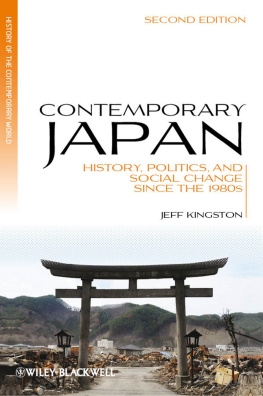Dimensions of Contemporary Japan
A Collection of Essays
Series Editor
Edward R. Beauchamp
University of Hawaii
Series Contents
1. History of Contemporary Japan, 19451998
2. Japanese Society sine 1945
3. Education and Schooling in Japan since 1945
4. Women and Women's Issues in Post World War II Japan
5. The Japanese Economy and Economic Issues since 1945
6. Japan's Role in International Politics since World War II
History of Contemporary Japan, 19451998
Edited with an introduction by
Edward R. Beauchamp
University of Hawaii
NEW YORK AND LONDON
First published by Garland Publishing, Inc
This edition published 2011 by Routledge
711 Third Avenue, New York, NY 10017
2 Park Square, Milton Park, Abingdon, Oxon, OX14 4RN
Introduction copyright 1998 Edward R. Beauchamp. All rights reserved.
Library of Congress Cataloging-in-Publication Data
History of contemporary Japan, 19451998 / edited with an
introduction by Edward R. Beauchamp.
p. cm. (Dimensions of contemporary Japan; 1)
Includes bibliographical references.
ISBN 0-8153-2728-5 (alk. paper)
1. JapanHistory1945 I. Beauchamp, Edward R., 1933-
II. Series.
DS889.H493 1998
Publisher's Note
The publisher has gone to great lengths to ensure the quality of this reprint but points out that some imperfections in the original may be apparent.
Contents
Richard H. Minear |
Carol Gluck |
Sheldon Garon |
John W. Dower |
Herbert P. Bix |
Barton J. Bernstein |
Sadao Asada |
Ray A. Moore |
Justin Williams Sr. |
Howard Schonbercjer |
Theodore McNelly |
Howard Schonberger |
J. Victor Koschmann |
Lonny E. Carlile |
Sheldon M. Garon |
Stephen J. Anderson |
Michael Hirsh and E. Keith Henry |
Karel van Wolferen |
Ryuji Mukae |
Kazuki Kasuya |
Introduction
World War II, or the Great Pacific War as it is known in Japan, is undoubtedly the seminal event in shaping the contours of contempory Japan. The war's carnage ended on August 14, 1945 when Japan accepted the Allied terms of surrender laid down in the Potsdam Declaration of July 26. The initial wave of American troops landed at the Imperial Navy's Yokosuka fortress on August 28, and the formal surrender took place on the deck of the battleship USS Missouri on September 2, 1945. This was quickly followed by the creation of the Supreme Command for the Allied Powers (SCAP), under the command of General Douglas MacArthur. The ensuing occupation of Japan lasted for six years and eight months, concluding with the signing of the Treaty of San Francisco on April 28, 1952. The surrender itself was not universally popular among key elements of the Japanese military and, indeed, attempts to undermine it contrary to the expressed will of the Emperor were subsequently aborted. The famous, and painfully symbolic, photograph that caught the great changes taking place is that of a formally dressed Japanese Emperor standing next to (some would say in the shadow of) an open collared General MacArthur who towers over the diminuative Hirihito.
The major goals of the occupation were straightforward enough the demilitarization, decentralization, and democratization of a militaristic state that had evolved from the frenzied modernization of late 19th-century Japan. The first step, demilitarization, began with the disarming and demobilization of Japanese forces, and the imperfect purging of extreme nationalists from all areas of public life. In many ways, this negative phase was the easiest. The Japanese people were exhausted from constant air bombardment, wartime food shortages, and the seemingly never ending flow of casualties that affected every family, yet they were quite willing to, in the words of their Emperor, ;endure the unendurable. Decentralization and democratization, on the other hand, proved more difficult. It is always easier to dismantle things than to build new ones. Indeed, Japan's modern history has been characterized by a marked centralizing trend. The modern Japanese imperial institution has always attracted power toward the center (or to those ruling in the emperor's name). A typically Japanese form of democracy gradually emerged in the early postwar years, but decentralization remained more problematic.
The first three essays in this volume (Minear, Gluck, and Garon) provide a broader historical context in which to study Japan's postwar experience. All three authors provide insight into earlier themes that have helped to shape the present. The following four essays (Dower, Bix, Bernstein, and Asada) discuss the dynamics of the surrender decision, while the Moore essay is an insightful analysis of the Occupation's significance in Japan's recent history. The contributions of Williams and Schoenberger lay out the traditional and revisionist view of the American democratization policy in the early postwar years. The remaining articles deal with other significant postwar issues, including Carlile's incisive analysis of the relationship between political parties and the Japanese labor movement, and Garon's explication of the role of the imperial bureaucracy and postwar labor policy. Hirsh and Henry provide a provocative explanation of the unraveling of Japan's prominent economic power in the recent past, and van Wolferen offers a widely popular critique of the failure of Japanese political reform. The volume concludes with a cogent essay on the Japanese inability to conclude a closure on the ghosts of World War II (Mukae), and with an influential journalist's reflections on postwar Japan (Kasuya).
All of these essays, and the issues they discuss, should be read in conjunction with the more detailed analyses contained in the series volumes that focus on economics, society, and the like. Read in this manner, the skeleton historical outline of this volume will be fleshed out in rich detail.
This collection of articles on modern Japanese society contains well over 100 scholarly pieces that have been written by leading academics in the field. It is drawn from both the most distinguished scholarly journals, as well as from other select journals that are not as well known. Many readers may be struck by the absence of material from the Journal of Japanese Studies. This is due to our inability to secure the necessary permissions from that journal to use their materials.
Review Symposium
Orientalism and the Study of Japan
RICHARD H. MINEAR
I n his autobiography Loren Eiseley wrote: One exists in a universe convincingly real, where the lines are sharply drawn in black and white. It is only later, if at all, that one realizes the lines were never there in the first place. But they are necessary in every human culture, like a drill sergeant's commands, something not to be questioned.1 We who are non-Japanese students of Japan form a culture of our own, and Edward Said's










